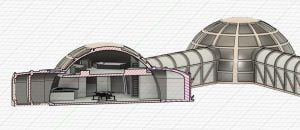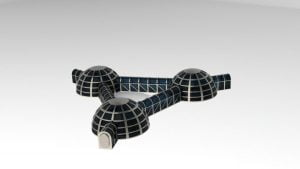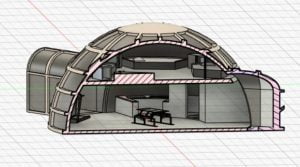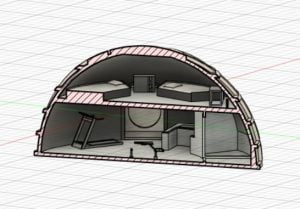Moon Camp Pioneers Gallery 2020-2021
In Moon Camp Pioneers each team’s mission is to 3D design a complete Moon Camp using Fusion 360. They also have to explain how they will use local resources, protect astronauts from the dangerous of space and describe the living and working facilities.
Team: Moonoids
“Tudor Vianu” National High School of Computer Science Bucharest Romania 15, 16
External viewer for 3d project
|
Project description
We designed a Moon Camp for four to six people in order to study the Moon and also to prepare for future space missions. Our purpose is to create a safe environment so our astronauts can stay on the moon for a longer period of time in order to conduct the necessary research. Our base will have three main units that will be connected via hermetically sealed tunnels and will allow further expansions when they will be needed. We also hope to be able to bring Helium-3 back to Earth, which could provide safer nuclear energy with no radioactive waste. |
|||
|
Where do you want to build your Moon Camp?
We want to place our Moon Camp near Shackleton Crater at the south pole. It has been proven by preliminary analysis of data from the European Space Agency satellite SMART-1 that the top of the hill on the southwest of Shackleton crater is constantly illuminated during the lunar southern summer. As the hill will have constant solar energy during the summer the problem about the energy source will be solved. Near the south pole, there are also the biggest ice deposits that we are going to use to obtain oxygen, hydrogen through hydrolysis and drinkable water, Shackleton crater is said to have water deposits so the astronauts would not have to travel far, thus saving resources. How do you plan to build your Moon Camp? Describe the techniques and materials you would use.
We will bring base materials from Earth. The robots designed on Earth will start building the airlocks and the main units at first. We have temperature, pressure and radiation among the variables that vary greatly from those on Earth. Since the astronauts will stay inside the Moon Camp, the temperature must remain constant. One of the best materials for thermal insulation(isolation?) is aerogel. It is a solid with extremely low density and because of that is very lightweight. Kevlar weighs little and has a high degree of hardness. Under extreme temperatures, kevlar doesn’t change its structure or form. As the Moon Camp will need windows to allow the astronauts to see out we are going to use thermal glass. The thermal glass will shield the astronauts from extreme temperatures and from the pressures of space. For objects such as chairs and tables and extra parts, we will use a 3D printer to get the parts we need. The environment on the Moon is very dangerous for the astronauts. Explain how your Moon Camp will protect them.
We are going to protect our Moon Camp by building 3 airlocks, one in each important unit so in the case of losing one of the units, the other two will remain intact, while protecting our astronauts from the inhabitable atmosphere. Using aerogel and thermal glass we will ensure the stability of temperature and oxygen levels. Radiation is one of the biggest problems and we plan on covering our Moon Camp with a layer of lunar rock, this being the best solution because it does not require bringing any materials from Earth. Our life-support systems and an extra room filled with any necessities will be built underground with access from all 3 units so they are more protected and could be used as a backup in case of an accident. Gravity causes muscle and bone eutrophication, so the astronauts will have a daily workout routine so they maintain their physical form. Explain how your Moon Camp will provide the astronauts with:
|
|||
|
Water
|
Food
|
Electricity
|
Air
|
|
We plan on getting drinkable water by melting the ice. The astronauts would get it from the ice deposits all around the south pole. We will use a filtration system based on metallic iron that we can get from regolith, through molten salt electrolysis which could also provide us with calcium and magnesium ions. We will use a lunar rover to go into the craters and get the ice. We will build mirrors on the edge of the craters that will direct the sunlight on the rover’s solar panels so we do not need to charge it from the camp. |
In the beginning, their diets would consist of plants that grow quick (algae) and nutritional bars brought from Earth. Broccoli is our main source of iron and vitamin C, soy provides protein, magnesium and vitamin D. They’ll get vitamin A and carbohydrates from sweet potatoes, zinc and calcium from lentils and vitamin K from edamame. Dates are a great source of sugar. Astronauts will be given meal plans that meet their caloric needs. The plants will grow in agar because it’s a more hygienic medium, it’s easier to work with and nutrients and vitamins can be added in exact amounts. |
Our main source of power will be solar energy which will be produced by the constant sunlight. The panels will power the entire Moon Camp and the surplus of energy is going to be stored in lead-acid batteries. These batteries will power the base at night. At night we will use a hydrogen generator to have maximum power. The best method to obtain high purity hydrogen gas is through water electrolysis. Another alternative solution is a fusion reactor which uses Helium-3 as fuel. Helium-3 is safer for nuclear energy since it doesn’t become radioactive and would not produce toxic waste products. |
As it is already known, breathable air is recommended to be composed of 20% oxygen and 78% nitrogen. First, we will use hydrolysis in order to get oxygen. Nitrogen will be brought from Earth in gas tanks. Because the crew will be able to bring a small amount of nitrogen, they will later use different methods to obtain it, such as synthesizing it from urea. Furthermore, the ice deposits will be our main source of oxygen and hydrogen which can be used as fuel, but we will also use the molten salt electrolysis process to remove oxygen from regolith. |
|
Explain what would be the main purpose of your Moon Camp (for example: commercial, scientific, and/or tourist purposes).
The main purpose of our project from a scientific point of view is to explore the moon and examining the possibility to live permanently on the Moon. We take into account the efficiency and eventuality to build a future colony that will later expand to other planets. If we are going to set a camp on the surface of the Moon we will make space travel easier and cheaper due to the low gravity the Moon has. Commercially speaking, our purpose will be to bring Helium-3 back to Earth and use it in nuclear reactors as an alternative energy source. We could also create a virtual “Moon Camp” so everybody on Earth can see what the astronauts are doing, how the base looks like. The people on Earth can learn more about the moon’s secrets and be up-to-date with new discoveries. |
|||
|
Describe a day on the Moon for your Moon Camp astronaut crew.
The crew will sleep in two shifts, such that at any time there will be at least 2 crew members awake. After waking up, the astronauts will shower and eat breakfast in the lobby. After that, they will work out for two hours, we will have to make sure the equipment they are going to use is suited for the Moon’s lower gravity. Studies have shown that astronauts experience up to a 20 per cent loss of muscle mass on space flights. They will have to constantly check the oxygen, hydrogen levels in the air, the integrity of the solar panels and the batteries. They will have daily tasks, like repairing the damaged items in the workshop, analysing samples in the laboratory, harvesting, taking care of the plants. If the temperature allows it, some of the members will go on missions outside and get data or samples. They will travel by a lunar rover which will be charged at the base for longer trips but it will also be equipped with solar panels of its own. The astronauts will each have time to communicate with their families and friends and also receive new tasks from the control centre back on Earth. While the astronauts will work to consolidate a self-sustainable Moon Camp they will still need supplies that will be sent from the Earth. The astronauts will be able to ask for parts in case something breaks and can not be replaced and also they will receive protein and vitamin bars. By setting a camp on the Moon, due to the lower gravity, it would be much cheaper to stock up for journeys farther away from the Earth. Analyzing how this first Moon Camp performs, how many resources it needs, we will be able to expand it and even create a research centre for the Moon and a control centre for future space exploration missions. |
|||









